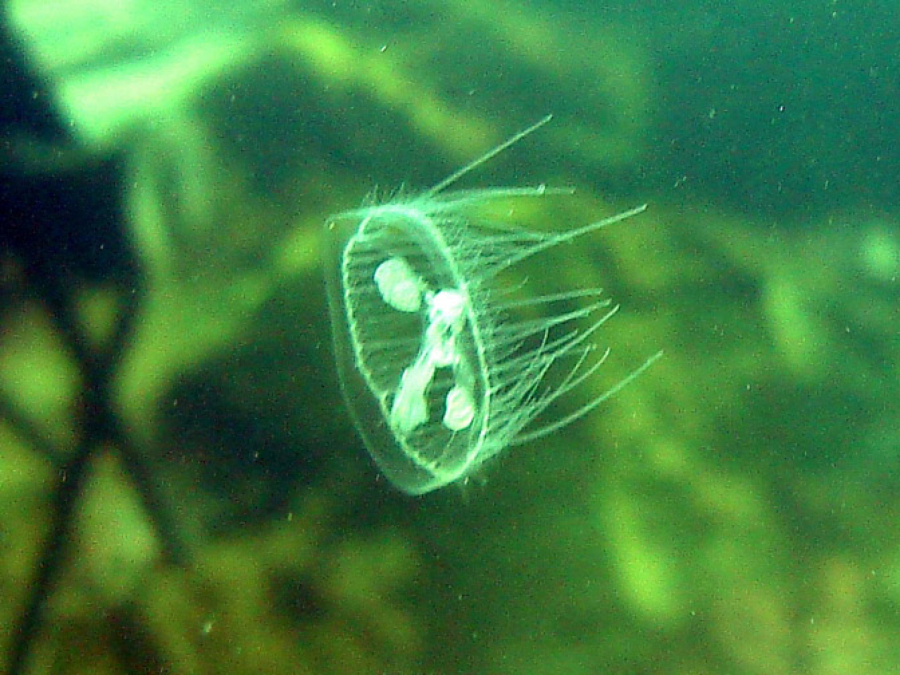Jodie Rogers was reluctant to tell too many people she spotted a jellyfish swimming in Battle Ground Lake because the first few didn’t buy it.
“I thought no one would believe me,” Rogers said.
For about the last 20 years, Rogers and her friend Caren Lorenz have kept a summertime ritual of swimming Battle Ground Lake. But they say it wasn’t until two or three summers ago that they started spotting whitish translucent little jellyfish undulating just below the surface.
“It was kind of surprising the first few times, because maybe I did think I was crazy,” Rogers said. She and Lorenz have now seen the creatures so often, especially this summer, that they’re unfazed.
Stacie Kelsey, a scientific technician with the Washington State Department of Fish and Wildlife, said whenever people call to report the creatures they do so expecting not to be believed.
But their tones quickly change when she says that not only does she believe them, but she probably knows where in the lake they spotted the jellyfish.
“Then they say ‘Oh, my God. How’d you know?’ ” Kelsey said.
She knows because her work focuses on the region’s inland waterways and she’s surveyed the lake for the quarter-sized invasive hydrozoans.
“The most I saw in one day was about 30,” she said.
She tells callers that wildlife officials know the jellyfish are there, and they’re not going to hurt you.
“They’re just fun little jellyfish to watch,” Kelsey said.
The jellyfish, whose scientific name is Craspedacusta sowerbii, is a freshwater animal that traces its origins to the Yangtze River of China.
It prefers calm waters, like lakes, ponds and old rock quarries. But how it managed to inhabit Battle Ground Lake and the waterways of a continent other than Asia remains a mystery.
It was first spotted in North America in Pennsylvania in 1885 and has been seen in at least 150 locations around the United States and Canada since.
Scientists believe it may have first hitched a ride on some of the ornamental aquatic plants exported out of the Yangtze Basin.
Justin Bush, executive coordinator of the Washington Invasive Species Council, said the jellyfish have been also seen in Snohomish, Spokane, and Stevens counties.
He said the jellyfish likely entered Battle Ground Lake when someone, who kept them as pets, decided to release them in the lake. Bush also said the jellyfish were first spotted in the lake in 2004. But Kelsey said she saw them there about a decade before that.
“They’re super interesting because they don’t necessarily show up in the water every year,” Kelsey said, adding that when they do show up it’s in the late summer. “They could show up in a lake once and never again, or show up once and not reappear for five or 15 years. It 100 percent depends on the right conditions — temperature specifically.”
Kelsey said she’s never seen them in high numbers or in clusters, but just as individuals ambling through the water.
The U.S. Geological Survey tracks where and when the jellyfish are sighted. So far the agency has never heard of them doing any meaningful harm once they move in, said Florida-based USGS biologist Pam Fuller.
“It’s more of an annoyance. I’m not sure anyone has proved any impact from this species,” she said. “It is going to eat some of the zooplankton, that other (small aquatic animals) would eat, but not so much that the others starve.”
Like their saltwater cousins, the freshwater jellyfish catch their prey (in this case, tiny organisms called zooplankton) with poisonous tentacles that hang from their bell-shaped bodies. But unlike saltwater jellyfish, the freshwater variety found in Battle Ground Lake are believed to be too small to penetrate human skin.
But the two swimmers aren’t so sure. In fact, Lorenz felt the creature before she saw it.
“Last summer we both, Jodie and I, noticed a very mild sting,” but only the one time each, Lorenz said. “Someone said they don’t sting, I said, well they do very gently.”
As far as invasive species go, the jellyfish doesn’t make much of an impact, but people should still do what they can to keep them from spreading.
It’s against the law to transport aquatic invasive species, and doing so can lead to jail time and thousands of dollars in fines.
The Invasive Species Council urges people to clean, drain and dry their equipment before going from one water body to the next to prevent the spread of invasive plants and animals.




